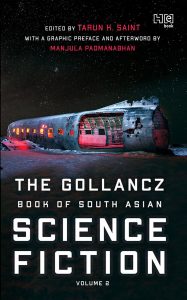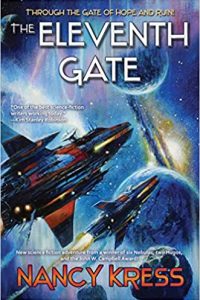Gary K. Wolfe Reviews The Gollancz Book of South Asian Science Fiction: Volume 2 by Tarun K. Saint, ed.
 The Gollancz Book of South Asian Science Fiction: Volume 2, Tarun K. Saint, ed. (Hachette India 978-9391028626, ₹699.00, 488pp, hc; $10.99, eb) September 2021.
The Gollancz Book of South Asian Science Fiction: Volume 2, Tarun K. Saint, ed. (Hachette India 978-9391028626, ₹699.00, 488pp, hc; $10.99, eb) September 2021.
The first volume of Tarun K. Saint’s The Gollancz Book of South Asian Science Fiction (reviewed here in June 2019) seemed to serve two purposes: to present the variety of South Asian SFF to the world at large, and – equally important, to judge from Saint’s introduction – to familiarize South Asian readers themselves with their own SFF traditions (as with other national and regional literatures, South Asian authors have not escaped the ongoing struggle to gain literary respectability for genre fiction). While generally an excellent anthology, it was somewhat limited by featuring only authors from the “partition states” of India, Pakistan, and Bangladesh. Saint’s second volume consists of mostly original stories and poems, still predominantly from these countries, but including authors from Sri Lanka, Pakistan, Bangladesh, and the Tibetan community in exile. Of the 29 stories and three poems here, three are in translation. As with the first volume, Saint provides a lengthy and thoughtful annotated introduction, in which he offers two ways of approaching South Asian SF: “as a graft, a splicing of a new element into the already extant corpus of South Asian literature, or as a subgenre that is different with new, unusual fruits that taste neither like its progenitors nor quite like anything else.” Together, he argues that these approaches constitute “a New Wave of South Asian SFF.” As with all new waves, this means a blurring of familiar lines between SF, fantasy, horror, postmodern fabulation, absurdism, surrealism, and traditional literary forms.
While it would be reductive to look for generalizations about such a diverse group of voices, there are nevertheless underlying histories and traditions that we seldom see addressed in western SFF. The lead story, for example, Shiv Ramdas’s Hugo- and Nebula Award-nominated “And Now His Lordship is Laughing”, is in one sense a familiar “magic doll” tale, but it’s set during a Bengal famine in 1943, deliberately engineered by the British and described in the visceral terms of a horror story. The aging doll maker Apa, who has consistently refused a British captain’s orders to produce a doll for the governor’s wife, finds an appropriately gruesome way to use her magic for revenge. It’s the most powerful portrayal of brutal colonialism in the book. Usman T. Malik also makes use of a horror conceit in “Resurrection Points” – the narrator’s magical ability to reanimate the dead with a touch – but sets it against a background of religious intolerance in Pakistan. Both Kalsang Yangzom in “The Crossing” and Salik Shah in “Shambala” address the plight of Tibetan exiles, the former ending on another note of horror, the latter effectively invoking Tibetan folklore.
If only a few of the stories address specific contemporary issues, the figure of the exile, along with the excluded, the exploited, and the simply irrelevant, recurs with some regularity. Senaa Ahmad’s “The Glow-in-the-Dark Girls” extrapolates from the actual history of young girls exposed to radiation from painting watch faces to imagining girls actually transformed into bioweapons. An imprisoned former journalist, rather suggestively named Severian, is the protagonist of Yudhanjaya Wijeratne’s grim fable “Confessor”. Arjun Raj Gaind’s Kafkaesque “The Ministry of Relevance” finds a writer desperately trying to argue for his worth in a postliterate society, a theme echoed by Navin Weeraratne’s “The Diamond Library”, set in a grim subterranean far future in which literacy and libraries are all but extinct. In Gautam Bhatia’s “The List”, the planet Xolon determines who is permitted to remain in their society based on an algorithm-derived list of the acceptable. Echoes of Kafka again show up in Vajra Chandrasekera’s antiwar parable “The Maker of Memorials” and Manjula Padmanabhan’s “The Pain Merchant”, the titular figure of which collects and resells the experience of pain in a world where it has all but been eliminated.
Bhatia’s tale, with its overtones of space opera, is far from the only story to make use of familiar SF themes. Environmental apocalypse provides the background for Soham Guha’s “The Song of Ice”, set in an extended winter following the massive explosion of the Yellowstone dome, while Premee Mohamed’s “The Arrival of the New World”, begins as a mystery involving missing tourists and turns into an effective nature-takes-revenge horror tale. An ancient technological artifact sets off a chain of complex events that eventually call into question the nature of physics in Anil Menon’s “Paley’s Watch”, probably the most intriguing example of literary hard SF here (its idea of physics as narrative is especially provocative), and ancient astronauts even make an appearance in Giti Chandra’s “A Species of Least Concern”, a mordantly funny feminist critique of speciesism set in a world that can best be described as post-nature. There’s also a fair amount of humor in Shovon Chowdhury’s slight but entertaining “Malini”, whose protagonist falls hopelessly in love with his phone’s automated voice, and Sukanya Datta’s invocation of tall-tale narratives “The Midas Touch”, which among other things features microbes that poop gold. “Almost Human”, by Kehkashan Khalid, evokes Asimov in a tale of an obsolete robot taken out of storage to help with a murder investigation.
Not surprisingly, Vandana Singh offers one of the most gracefully written tales with the distinctly Le Guin-flavored “A Different Sea”, which explores the challenges of alien friendship with a rediscovery of lost voices from the past. Perhaps the most ambitious foray into hard-SF space opera is Haris A. Durrani’s “Chompollion’s Foot”, which nominally deals with the exploration of a long-dead civilization on a sunless planet, but considers the implications of humanity’s failure to discover, after 24 millennia of searching, any evidence of surviving intelligences elsewhere in the universe. Like several other stories here, it combines some rigorous thinking about how the past can be almost inadvertently obliterated (the title refers to a famous statue in Paris in which the translator of the Rosetta Stone, and putative founder of Egyptology, is portrayed with his foot on the head of a pharaoh) with elements of folk beliefs; this may be one of the few stories anywhere, though, that combines Dominican and Pakistani legends, reflecting Durrani’s dual heritage. The story very nearly bites off a bit more than it has room to chew, but it offers a thoroughly original perspective on a classic SF problem. And perspective, in the end, is much of what Saint’s second anthology has to offer: a selection of stories that makes no effort to tick off a predetermined set of boxes, but that presents an impressive variety of individual voices who, more often than not, remind us that there are more angles of vision than our own.
Gary K. Wolfe is Emeritus Professor of Humanities at Roosevelt University and a reviewer for Locus magazine since 1991. His reviews have been collected in Soundings (BSFA Award 2006; Hugo nominee), Bearings (Hugo nominee 2011), and Sightings (2011), and his Evaporating Genres: Essays on Fantastic Literature (Wesleyan) received the Locus Award in 2012. Earlier books include The Known and the Unknown: The Iconography of Science Fiction (Eaton Award, 1981), Harlan Ellison: The Edge of Forever (with Ellen Weil, 2002), and David Lindsay (1982). For the Library of America, he edited American Science Fiction: Nine Classic Novels of the 1950s in 2012, with a similar set for the 1960s forthcoming. He has received the Pilgrim Award from the Science Fiction Research Association, the Distinguished Scholarship Award from the International Association for the Fantastic in the Arts, and a Special World Fantasy Award for criticism. His 24-lecture series How Great Science Fiction Works appeared from The Great Courses in 2016. He has received six Hugo nominations, two for his reviews collections and four for The Coode Street Podcast, which he has co-hosted with Jonathan Strahan for more than 300 episodes. He lives in Chicago.
This review and more like it in the December 2021 issue of Locus.
 While you are here, please take a moment to support Locus with a one-time or recurring donation. We rely on reader donations to keep the magazine and site going, and would like to keep the site paywall free, but WE NEED YOUR FINANCIAL SUPPORT to continue quality coverage of the science fiction and fantasy field.
While you are here, please take a moment to support Locus with a one-time or recurring donation. We rely on reader donations to keep the magazine and site going, and would like to keep the site paywall free, but WE NEED YOUR FINANCIAL SUPPORT to continue quality coverage of the science fiction and fantasy field.
©Locus Magazine. Copyrighted material may not be republished without permission of LSFF.






